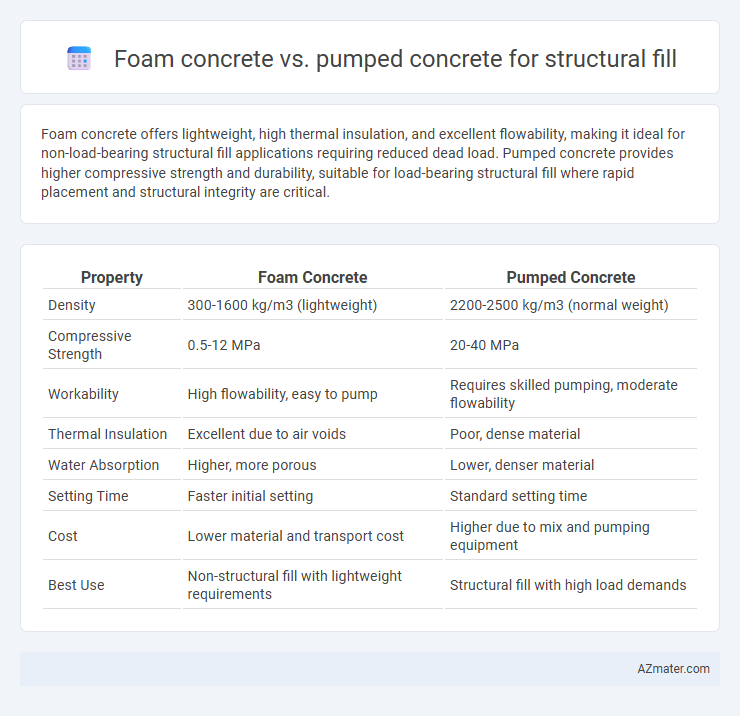Foam concrete offers lightweight, high thermal insulation, and excellent flowability, making it ideal for non-load-bearing structural fill applications requiring reduced dead load. Pumped concrete provides higher compressive strength and durability, suitable for load-bearing structural fill where rapid placement and structural integrity are critical.
Table of Comparison
| Property | Foam Concrete | Pumped Concrete |
|---|---|---|
| Density | 300-1600 kg/m3 (lightweight) | 2200-2500 kg/m3 (normal weight) |
| Compressive Strength | 0.5-12 MPa | 20-40 MPa |
| Workability | High flowability, easy to pump | Requires skilled pumping, moderate flowability |
| Thermal Insulation | Excellent due to air voids | Poor, dense material |
| Water Absorption | Higher, more porous | Lower, denser material |
| Setting Time | Faster initial setting | Standard setting time |
| Cost | Lower material and transport cost | Higher due to mix and pumping equipment |
| Best Use | Non-structural fill with lightweight requirements | Structural fill with high load demands |
Introduction to Structural Fill Solutions
Foam concrete offers lightweight, high-insulation properties and excellent flowability for structural fill applications, making it ideal for reducing load on underlying soils and providing thermal insulation. Pumped concrete, characterized by its higher density and compressive strength, is preferred for structural fills that require superior strength and durability under heavy loads. Selecting between foam concrete and pumped concrete depends on project-specific requirements such as load-bearing capacity, soil conditions, and thermal performance needs.
Overview of Foam Concrete
Foam concrete is a lightweight, cellular material created by mixing cement slurry with pre-formed foam, offering excellent thermal insulation and reduced self-weight compared to traditional pumped concrete. Its lower density, typically ranging from 400 to 1600 kg/m3, makes it ideal for structural fill applications where reduced load on underlying soils is critical. Foam concrete's highly flowable consistency allows easy filling of voids and complex shapes, enhancing ground stabilization and reducing settlement risks.
Overview of Pumped Concrete
Pumped concrete, a highly workable mixture composed of cement, aggregates, water, and admixtures, is delivered through pipelines using pumps for efficient placement in structural fill applications. This type of concrete provides superior strength, durability, and reduced shrinkage compared to foam concrete, making it ideal for load-bearing structures and heavy-duty fills. Its ability to be pumped over long distances and into complex formworks allows for faster construction and consistent compaction.
Material Properties Comparison
Foam concrete exhibits lower density and higher air content compared to pumped concrete, resulting in reduced compressive strength but superior thermal insulation and lightweight properties suitable for non-load bearing structural fill. Pumped concrete offers higher compressive strength and density due to its conventional cementitious mix with aggregates, making it ideal for load-bearing applications requiring durability and stability. The choice depends on specific project requirements such as structural load, thermal performance, and ease of placement.
Load-Bearing Capacity
Foam concrete offers a lower load-bearing capacity due to its lightweight, aerated structure, making it suitable for non-structural or lightweight fill applications. Pumped concrete, with its higher density and compressive strength, provides superior load-bearing performance ideal for structural fill requiring substantial support. Selecting pumped concrete ensures enhanced durability and stability in load-critical construction zones.
Installation and Workability
Foam concrete offers superior workability due to its lightweight and flowable nature, enabling easy placement in complex voids without heavy compaction, which reduces installation time and labor costs. Pumped concrete, while denser and stronger, requires more careful handling and skilled labor to ensure proper pumping and compaction, especially in structural fill applications where uniform density is critical. Installation efficiency of foam concrete is enhanced by its self-leveling properties, whereas pumped concrete demands rigorous control of mix consistency to prevent segregation and blockage during pumping.
Cost and Economic Considerations
Foam concrete offers lower material costs and reduced transportation expenses due to its lightweight nature, making it highly economical for large-scale structural fill projects. Pumped concrete, while typically more expensive per cubic meter, provides faster placement rates and improved compaction, potentially reducing labor costs and project duration. Economic considerations should balance initial material and pumping costs against long-term benefits like structural performance and site-specific requirements.
Durability and Longevity
Foam concrete offers enhanced durability for structural fill due to its lightweight cellular structure that reduces shrinkage and cracking over time, promoting longevity in unstable soil conditions. Pumped concrete, while denser and providing higher compressive strength, may be more prone to segregation and shrinkage cracks if not properly mixed and placed, potentially affecting long-term performance. Selecting foam concrete improves resistance to environmental degradation and reduces maintenance costs, making it highly suitable for durable structural fill applications.
Environmental Impact and Sustainability
Foam concrete offers a lower environmental footprint compared to pumped concrete due to its lighter weight, which reduces transportation emissions and requires less raw material, often incorporating recycled industrial by-products like fly ash. Pumped concrete, while denser and stronger for structural fill, consumes more energy during production and transportation, leading to higher carbon emissions. Using foam concrete can enhance sustainability by improving thermal insulation and reducing the need for extensive excavation, thus minimizing site disturbance and resource depletion.
Best Applications and Recommendations
Foam concrete offers excellent thermal insulation and lightweight filling properties, ideal for non-load-bearing structural fill and void filling in trench reinstatement and roof insulation. Pumped concrete provides higher compressive strength and durability, making it suitable for load-bearing structural fill, foundations, and large-scale infrastructure projects requiring rapid placement and compaction. For best results, choose foam concrete for projects prioritizing weight reduction and thermal performance, while pumped concrete is recommended for applications demanding higher strength and structural integrity.

Infographic: Foam concrete vs Pumped concrete for Structural fill
 azmater.com
azmater.com